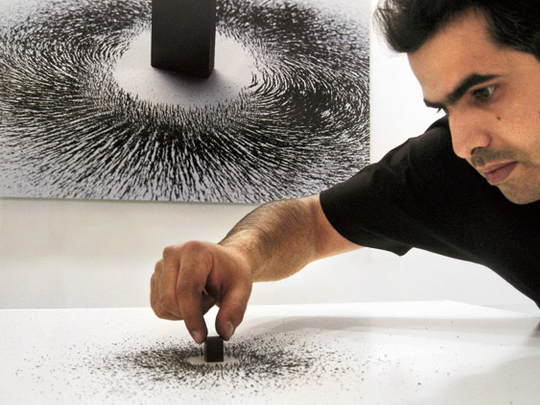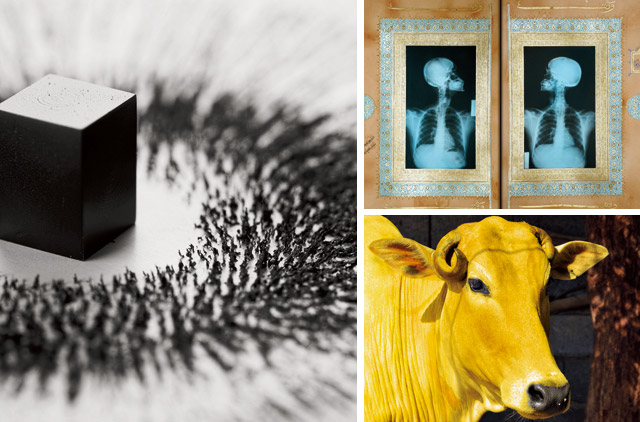
A decade ago, you could be forgiven for thinking that the words ‘Saudi Arabia’ and ‘contemporary art’ would never sit together comfortably in a sentence. But thanks to pioneering initiatives like Edge of Arabia, a London-based social enterprise that endeavours to take Saudi contemporary art to the world, the aforementioned words are no longer strange bedfellows.
At the forefront of the fledgling Saudi art scene is the work of artists like Ahmad Mater and Abdulnasser Gharem. The former recently became the first Saudi artist to have a monograph published. At the unveiling of his book in Dubai, we managed to sneak a few words with Ahmad Mater and his Edge of Arabia collaborator Stephen Stapleton, who is one of the contributors to the book. Other contributors include Venetia Porter (from the British Museum), Tim Mackintosh-Smith (Arabist and travel writer) and blogger Ahmad Al Omran.
The cover of your book refers to your Yellow Cow Project? Tell us about it?
This was inspired by a story from the Quran, Surah Al Baqarah [Ed’s note: The Surah contains many commandments, but Ahmad focuses on two key incidents between Moses and the Israelites: their fall into idolatry and God’s commandment to sacrifice a yellow cow]. On my farm in Abha (a village in the mountainous Aseer region of south-western Saudi Arabia), I coloured a cow yellow. I spent time observing the reaction of those who saw the yellow cow based on what they had read in the Quran. It was crazy; they couldn’t believe what they were seeing. I wanted to release the messages held within the Surah. The next step involved mass production and line extensions. I created a brand called Yellow Cow to market everything from yoghurt, and butter to cheese. But I didn’t stop there, I began to market it – I was on a mission to flood the market with Yellow Cow, send it to every home, every street. It had to be everywhere, people wouldn’t be able to ignore it. The idea was to get people thinking about
the era of consumerism that we live in now.
How did those around you react to your art?
Well, I do get people asking me why I’m doing the things I do, like painting a cow yellow when I could have done something more useful with my time. But I guess that’s understandable, given the lack of awareness back home about contemporary art.
You are a doctor by profession. But over the years, you’ve gained a fair bit of recognition both within Saudi Arabia and internationally as a contemporary artist. Do you think it’s time to give up your day job?
My work, my tools provide me the context formy art. I’m inspired by my everyday life. I don’t know any other way. I honestly wouldn’t know what to do as an artist if I couldn’t go to the hospital any more. So no, I’m not giving up my day job yet. Most Saudi artists straddle two worlds; we have careers as doctors, soldiers, teachers and engineers. I have two separate lives; one is my profession which is very objective and then art, a very subjective one.
Contemporary art is yet to gain mainstream acceptance in Saudi Arabia. Is the lack of awareness frustrating? Do you feel that sometimes people don’t get the point of your art?
When I create art, I often hope that this will get people thinking, promote dialogue. Especially among the younger generation – give them something to think about. And people do react to what they see, especially the younger generation of Saudis.
Stephen Stapleton adds: “What sets him apart from Western contemporary artists is that his work is accessible to the layman. Ahmad’s work is inspired by his surroundings. For example, the Evolution of Man series struck a chord with the youth in Saudi Arabia. In the West, the artist will not necessarily worry about whether the layman understands his creative leanings.”
How much has the Edge of Arabia movement and artists such as yourself and Abdulnasser Gharem done towards inspiring the next generation of Saudi contemporary artists?
Mater: With increased government support and funding, there are positive changes on the Saudi contemporary art scene. There are a lot of young artists who, encouraged by initiatives like Edge of Arabia, are looking at ways of expressing themselves. Saudi Arabia has a large young population, so there’s plenty of scope for growth. There are galleries opening, the artists are less inhibited now. Having the Saudi Pavilion at the 54th Venice Biennale this year is another indication of how perceptions are changing about Saudi contemporary art both inside and outside the kingdom.
Stapleton: Things are changing. The good thing about Saudi Arabia and the GCC region is that things happen fast here. Look at Al Quoz – not long ago just an industrial area, now teeming with art galleries. We are trying to impress upon the Saudi Government that for a creative economy to flourish, we need to value creativity, create awareness. It has to be a bottom-up, top-down approach.
*He was placed 62nd in Arabian Business magazine’s list of the most influential Arabs in 2009
- Name: Ahmad Mater
- Age: 31
- Nationality: Saudi Arabian
- Claim to fame: The most influential Saudi contemporary artist
- Lives in: Abha
- Other job: Doctor
- Website: www.ahmedmater.com



